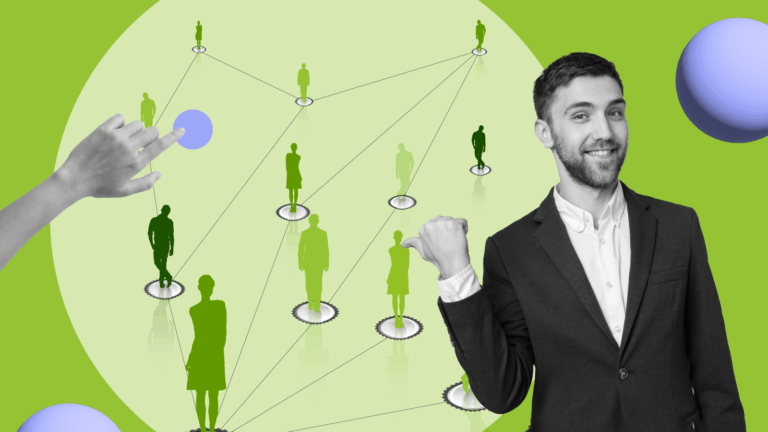
Learning experience platforms (LXP): A guide
Modern organizations face an unprecedented challenge: keeping their workforce skilled and adaptable in a rapidly evolving digital landscape. Traditional training methods often fall short of meeting the dynamic learning needs of today’s professionals. Enter learning experience platforms (LXP)—sophisticated digital solutions that revolutionize how employees acquire, develop, and apply new skills.
The transformation is already underway. The LXP market reached $2.10 billion in 2023, projected to hit $2.81 billion by 2025, with organizations worldwide recognizing that investing in learner-centric platforms isn’t just beneficial—it’s essential for competitive advantage. As Johanna Bolin Tingvall, Global Head of L&D at Spotify, notes: “Skills for the same occupation changed by about 25% between 2015 and 2021. At this rate, by 2025, skills needed for the average job will have changed by at least 40%.”
- Understanding learning experience platforms (LXPs)
- LXP vs. LMS: Key differences and when to use each
- Key features of top learning experience platforms
- Proven benefits and ROI of LXP implementation
- Implementation best practices and common challenges
- Real-world success stories and case studies
- Future trends and strategic considerations
- Technical terms glossary
- Conclusion: Embracing the potential of learning experience platforms
Understanding learning experience platforms (LXPs)
Definition and purpose of LXPs
A learning experience platform (LXP) represents a fundamental shift from traditional top-down training approaches to learner-driven educational journeys. Unlike conventional systems that prioritize administrative control, LXPs place the learner at the center of the experience, enabling self-directed, personalized, and flexible learning paths.
These platforms leverage artificial intelligence and machine learning algorithms—sophisticated systems that analyze user behavior patterns, performance data, and engagement metrics—to curate, recommend, and deliver content tailored to individual needs, interests, roles, and skill gaps. AI-driven personalization refers to technology that automatically adjusts learning experiences based on individual preferences and performance, while adaptive learning paths are customized sequences of educational content that modify based on learner progress.
What sets LXPs apart is their ability to integrate diverse content formats—videos, articles, podcasts, interactive modules, and real-world assignments—from both internal and external sources into a cohesive learning ecosystem. Microlearning modules, which are bite-sized educational content pieces designed for quick consumption, become integral components alongside social learning features that enable peer collaboration and knowledge sharing.
Evolution and history of digital learning environments
Digital learning has undergone remarkable transformation since its early days of instructor-led training and static e-learning modules. As HR industry analyst Josh Bersin noted three years ago, many companies were ready to “put their learning management system (LMS) in the basement”—likening an LMS to a flip phone in the digital age. Today, LXPs have emerged as more advanced and necessary solutions.
Traditional Learning Management Systems (LMSs) emerged primarily as administrative tools, designed for managers to assign, track, and report on mandatory training and compliance requirements. The shift toward learning experience platforms reflects broader technological trends and changing workforce expectations, with employees craving autonomy in their professional development and resources that align with specific roles and career aspirations.
Current trends in LXP development
The LXP landscape continues evolving rapidly, with the market expected to climb to nearly $29 billion by 2033, reflecting a compound annual growth rate of 33.79%. This expansion is fueled by increased investments in melhoria de competências e requalificação initiatives across industries.
AI-driven personalization leads current development trends, with platforms becoming increasingly sophisticated in delivering hyper-personalized learning experiences. Mobile-first design has become non-negotiable, reflecting the reality that professionals need learning resources accessible anytime, anywhere. Social and collaborative learning features are expanding rapidly, incorporating peer-to-peer sharing, discussion forums, and gamification elements like badges, leaderboards, and achievements to boost motivation.
LXP vs. LMS: Key differences and when to use each
Core differences between LXPs and LMSs
Understanding the distinction between learning management systems and learning experience platforms is crucial for making informed technology decisions. LMSs operate as admin-driven platforms, emphasizing structured, compliance-based training and top-down content delivery. Administrators assign courses, set learning paths, and control content access, typically within formal training scenarios.
LXPs prioritize the learner’s journey, offering personalized, flexible, and open-ended content discovery. They excel at personalizing learning through AI-powered recommendations, curating content from multiple sources—internal, external, and user-generated—and tailoring resources to individual learning styles and career goals.
The content approach differs significantly between these systems. LMSs typically limit content to internally curated materials within structured, often mandatory learning paths. LXPs aggregate resources from diverse sources, creating comprehensive, searchable libraries that support continuous, self-directed learning while incorporating social features that encourage community-driven knowledge sharing.
Strategic platform selection
Many modern solutions recognize that organizations need both structured and flexible learning approaches. Leading platforms increasingly blend LMS and LXP functionalities, providing comprehensive learning ecosystems that support both compliance requirements and continuous development initiatives.
LMSs remain ideal for formal, mandatory training scenarios including compliance programs, regulatory certification, and structured onboarding processes. LXPs excel in supporting ongoing professional development, skill building, and fostering cultures of continuous learning, particularly valuable for organizations operating in rapidly changing industries.
Key features of top learning experience platforms
Personalization and adaptive learning technology
Modern LXPs leverage artificial intelligence and machine learning to create highly personalized learning experiences that adapt to individual users’ needs, preferences, and performance patterns. These adaptive learning systems adjust the pace, sequence, and format of materials based on individual progress and identified skill gaps, ensuring learners receive appropriately challenging content that builds upon existing knowledge.
The sophistication of personalization engines reflects advances in data analytics and machine learning. These systems continuously refine recommendations based on learner feedback, completion patterns, and performance outcomes, creating increasingly accurate and valuable learning experiences that align with professional aspirations.
Social learning and community features
Recognition that learning is inherently social has driven significant investment in community features within leading LXPs. Built-in tools for discussion, peer feedback, and knowledge sharing encourage collaboration and collective problem-solving, with user-generated content capabilities empowering employees to contribute insights and best practices that enrich the overall learning ecosystem.
Active communities help sustain engagement by creating belonging among learners. Discussion forums, peer review systems, and collaborative projects foster connections that extend beyond individual learning activities, building networks that support ongoing professional development.
Integration and analytics capabilities
Seamless integration with existing enterprise systems represents a critical success factor for LXP implementations. Modern platforms offer robust connectivity with HR systems, CRMs, and productivity tools through APIs and pre-built connectors, ensuring learning becomes embedded in daily workflows.
Advanced analytics capabilities distinguish leading LXPs from traditional platforms. Comprehensive dashboards track learner engagement, progress, completion rates, and knowledge retention, providing actionable insights for both individual learners and organizational leaders. This data-driven approach enables continuous improvement of content and instructional strategies.
Proven benefits and ROI of LXP implementation
Measurable learning outcomes and engagement
The shift toward learner-centric design delivers significant improvements in engagement and motivation. Digital learning platforms boost retention rates from 8-10% up to 25-60%, thanks to personalization and microlearning features. Organizations implementing LXPs report that login frequency and content interaction rates increased by over 40% after deploying adaptive learning journeys.
AI-assisted skill taxonomy within LXPs led to a 20% increase in user adoption of upskilling programs, demonstrating how personalized approaches accelerate skill development. Companies utilizing robust integration of knowledge management and learning platforms see a 36% increase in productivity, decision-making, and collaboration.
Cost savings and business impact
Organizations implementing LXPs save up to 60% on training costs while simultaneously driving measurable improvements in key performance indicators. The global eLearning market is projected to reach $325 billion, with companies reporting substantial efficiencies by replacing classroom training with digital solutions.
Cloud-based architecture and flexible licensing models enable organizations to scale learning programs efficiently as their workforce expands. Automated administration capabilities reduce manual workload associated with user management, content curation, and progress tracking, supporting rapid onboarding without proportional increases in administrative overhead.
Skills development and workforce readiness
LXPs promote cultures of ongoing learning by making resources readily available and encouraging self-directed exploration. The platforms’ adaptability ensures learning initiatives remain aligned with evolving business needs, proving particularly valuable for organizations in technology sectors where skill requirements evolve rapidly.
Recent case studies demonstrate concrete outcomes. ERA’s ClickLearn implementation resulted in significantly reduced onboarding times and faster adoption of complex internal software, while Multiplex experienced measurable decreases in help desk tickets and improved user satisfaction scores.
Platform selection criteria
Successful implementations prioritize platforms offering engaging user experiences, robust personalization engines, and comprehensive analytics capabilities that demonstrate clear value and return on investment. Integration capabilities deserve particular attention, as seamless connectivity with existing systems significantly impacts user adoption and administrative efficiency.
Content quality and variety represent critical success factors. Evaluate both built-in content libraries and support for user-generated materials, ensuring the platform can accommodate diverse learning preferences and organizational knowledge sharing initiatives.
Implementation best practices and common challenges
Expert insights on implementation challenges
Industry professionals identify several key challenges in LXP deployment. High initial investment and ROI justification remain primary concerns, with L&D leaders emphasizing the need for careful ROI assessments before committing to significant platform investments.
Resistance to change represents another significant barrier, particularly among staff accustomed to traditional LMS approaches. Data from a Harvard Business Review manager survey reveals that approximately 75% of managers remain dissatisfied with their company’s L&D function, highlighting ongoing challenges in aligning training platforms to tangible business outcomes.
Proven implementation strategies
Successful deployments require involving stakeholders early and communicating clearly about platform benefits and alignment with both company and individual growth objectives. L&D professionals recommend continuous content review in partnership with internal experts to ensure relevance and rigor.
Organizations should focus on measuring impact and maintaining agility to recalibrate content or delivery methods as needs change. Setting clear KPIs tied to business outcomes, with frequent measurement and flexibility, proves essential for long-term success.
Step-by-step implementation checklist
Phase 1: Planning and assessment (4-6 weeks)
- Conduct comprehensive needs assessment identifying learning objectives and target audiences
- Define success metrics and ROI expectations
- Evaluate integration requirements with existing systems
- Secure stakeholder buy-in and establish project governance
Phase 2: Platform selection and configuration (6-8 weeks)
- Complete vendor evaluations and proof-of-concept testing
- Configure platform settings and integration connections
- Develop content migration and organization strategy
- Create user roles and permission structures
Phase 3: Content development and testing (8-12 weeks)
- Migrate or create initial content library
- Establish content governance and quality standards
- Conduct user acceptance testing with pilot groups
- Develop training materials and support resources
Phase 4: Deployment and adoption (4-6 weeks)
- Execute phased rollout to target user groups
- Provide comprehensive user training and support
- Monitor adoption metrics and address user feedback
- Establish ongoing optimization and maintenance processes
Real-world success stories and case studies
Technical skills assessment integration
Kodilla, a leading coding bootcamp in Poland, adopted DevSkiller to automate programming skills assessment, demonstrating how real-world technical assessments enhance learning outcomes. The implementation improved mentor satisfaction and enabled Kodilla to scale programs, supporting graduates’ transition to employment at major companies like Amazon, IBM, and Accenture.
Clevertech streamlined their technical interview process using DevSkiller, providing candidates quick opportunities to demonstrate technical abilities. DevSkiller’s assessments provided objective, skills-based evaluation, leading to more efficient and fair selection processes for technical roles.
Enterprise implementation outcomes
Manufacturing enterprises implementing adaptive content LXPs report login frequency and content interaction increases exceeding 40% after deploying personalized learning journeys. Teams using adaptive LXPs achieved operational targets sooner than historical averages, with session duration lengthening to indicate increased learning engagement.
Global consulting firms track weekly logins and 30-minute average session durations, demonstrating both broad reach and deep engagement. Management identifies learning trend surges after product launches, helping align future training investments with business priorities.
Future trends and strategic considerations
Emerging technologies and market evolution
The LXP landscape continues evolving rapidly, with AI advancement promising deeper personalization through predictive analytics that anticipate learning needs before skill gaps become critical. Immersive learning experiences through augmented reality, virtual reality, and interactive simulations will become more mainstream, offering hands-on skill development opportunities that closely mirror real-world work scenarios.
Enhanced focus on data privacy, accessibility, and inclusivity will shape platform design as organizations recognize the importance of creating learning environments that serve diverse populations while maintaining strict security standards.
Preparing for workforce transformation
Organizations leveraging LXPs gain significant advantages in preparing their workforce for rapidly changing business environments. These platforms support agile learning approaches that enable just-in-time skill development and large-scale upskilling initiatives responding quickly to market changes.
Companies implementing comprehensive skills assessment and development programs, similar to DevSkiller’s TalentBoost approach mapping over 3,000 digital and IT skills, can identify skill gaps early and provide targeted development pathways aligning with both individual career goals and organizational needs.
Technical terms glossary
AI-driven personalization: Technology that automatically adjusts learning experiences based on individual user behavior, preferences, and performance data to deliver customized content recommendations.
Adaptive learning paths: Customized sequences of educational content that modify in real-time based on learner progress, performance, and identified skill gaps.
Microlearning modules: Bite-sized educational content pieces, typically 3-5 minutes long, designed for quick consumption and easy integration into busy work schedules.
Social learning features: Platform capabilities that enable peer collaboration, knowledge sharing, discussion forums, and community-driven content creation.
Learning analytics: Data collection and analysis tools that track learner engagement, progress, completion rates, and performance outcomes to inform decision-making.
Conclusion: Embracing the potential of learning experience platforms
Learning experience platforms represent a transformative evolution in digital learning, fundamentally shifting focus from administrative convenience to learner empowerment and engagement. Organizations embracing this learner-centric approach position themselves to meet rapidly evolving workplace demands while fostering cultures of continuous growth and innovation.
The compelling market growth projections and documented success stories demonstrate that LXP adoption transcends trend following to become strategic necessity. With 98% of corporations planning eLearning implementation and proven ROI through 36% productivity increases, companies implementing modern learning experience platforms create competitive advantages through improved employee engagement and accelerated skill development.
Success with LXPs requires more than technology deployment—it demands commitment to learner empowerment, data-driven decision making, and continuous platform optimization. Organizations approaching LXP implementation strategically, with clear objectives and sustained support, discover transformative potential extending far beyond traditional training boundaries. The future belongs to companies recognizing learning as a continuous journey rather than discrete events, creating sustainable competitive advantages while empowering their workforce to thrive.




